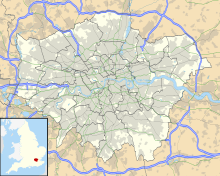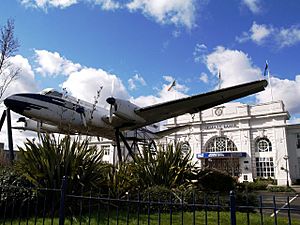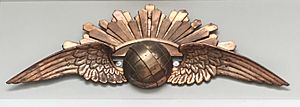Croydon Airport facts for kids
Quick facts for kids
Croydon Airport
|
|||||||||||||||||||
|---|---|---|---|---|---|---|---|---|---|---|---|---|---|---|---|---|---|---|---|
 |
|||||||||||||||||||
| Summary | |||||||||||||||||||
| Airport type | Public | ||||||||||||||||||
| Location | Croydon | ||||||||||||||||||
| Opened | 1920 | ||||||||||||||||||
| Closed | 1959 | ||||||||||||||||||
| Coordinates | 51°21′23″N 000°07′02″W / 51.35639°N 0.11722°W | ||||||||||||||||||
| Map | |||||||||||||||||||
| Runway | |||||||||||||||||||
|
|||||||||||||||||||
|
Runway Details:
|
|||||||||||||||||||
Croydon Airport was the United Kingdom's main and only international airport between World War I and World War II. It was located in Croydon, South London, England. The airport opened in 1920. It was built in a Neoclassical style.
Croydon Airport became Britain's most important airport. It handled more cargo, mail, and passengers than any other UK airport at the time. Important new ideas started here. These included the world's first air traffic control system and the first airport terminal building.
During World War II, the airport was known as RAF Croydon. It became a fighter airfield during the Battle of Britain. In 1943, RAF Transport Command was created at the airport. This group used the airport to move thousands of troops into and out of Europe.
After the Second World War, Croydon Airport went back to being a civil airport. However, London Heathrow Airport became London's main international airport. Croydon Airport closed in 1959. It had been known by eight different names during its active years.
In 1978, the main terminal building and the Gate Lodge were protected as Grade II listed buildings. In May 2017, Historic England upgraded the terminal building to Grade II*. This means it is a very important historic building. The Gate Lodge is now in need of repair and is on the "Heritage at Risk" list.
Contents
History
How it Started
In December 1915, Beddington Aerodrome was set up. This was one of several small airfields around London. They were built to protect against Zeppelin airship attacks during World War I. In January 1916, the first two aircraft arrived. They were B.E 2C's, part of the Home Defence.
Waddon Aerodrome opened in 1918. It was next to National Aircraft Factory No. 1. This airfield was used for testing aircraft. The two airfields were on opposite sides of Plough Lane. This lane ran north from Russell Hill near Purley.
Beddington Aerodrome became a large training airfield for the Royal Flying Corps. After World War I, it remained an important training base for the new Royal Air Force. In 1919, Prince Albert (who later became King George VI) learned to fly here. He was the first member of the Royal Family to earn his "wings". His older brother, the Prince of Wales (later Edward VIII), also trained here in 1919.
The two airfields were combined after World War I. They became Croydon Aerodrome. This new airport was the main entry point for all international flights to and from London. It opened on March 29, 1920. It replaced a temporary airfield at Hounslow Heath.
Plough Lane remained a public road crossing the airport. Traffic had to stop when planes were landing or taking off. At first, a person with a red flag stopped cars. Later, a gate was used. The airport helped regular flights grow. These flights carried passengers, mail, and goods. The first destinations were Paris, Amsterdam, and Rotterdam. In 1923, flights to Berlin Tempelhof Airport also began.
Penshurst Airfield was used when Croydon was closed due to fog. This happened until Penshurst closed on July 28, 1936.
Croydon was the first airport in the world to have air traffic control. It also had the first control tower and radio systems to find plane positions. The control tower was 15 feet high. It had windows on all four sides. It started on February 25, 1920. It gave pilots basic information about traffic, weather, and their location.
Britain's first national airline, Imperial Airways, started on March 31, 1924. Croydon became its main base. Imperial Airways was chosen by the British Government. Its job was to connect the UK with its many overseas territories. From Croydon, Britain developed its routes to Europe, India, Africa, the Middle East, and Australia.
After a plane crash in December 1924, conditions at Croydon were criticized. This led to a new law, the Croydon Aerodrome Extension Act 1925. This law allowed for a big expansion of the airport.
Growing Bigger
Between 1926 and 1928, the airport became much larger. New buildings were constructed next to Purley Way. These included the first airport terminal designed specifically for that purpose. It also had the world's first airport hotel and large hangars. The new airport cost about £267,000. Plough Lane was permanently closed. This allowed larger planes to land and take off safely.
The airport's terminal building and control tower were finished in 1928. The old wooden control building was removed. The new buildings started operating on January 20, 1928. They were officially opened on May 2, 1928, by Lady Maud Hoare.
Croydon was where regular international passenger flights began. At first, they used old wartime planes. The route between Croydon and Le Bourget soon became the busiest in the world. Air traffic control was first developed here. The "Mayday" distress call also started here.
Many famous people used Croydon Airport. Amy Johnson took off from Croydon on May 5, 1930. She made a record-breaking flight to Australia. In 1927, Charles Lindbergh arrived in his plane, Spirit of St. Louis. He was met by over 100,000 excited people. Winston Churchill also took flying lessons at Croydon.
On July 11, 1936, Major Hugh Pollard and Cecil Bebb left Croydon Airport. They flew to the Canary Islands. There, they picked up General Francisco Franco. They took him to Spanish Morocco. This event helped start the Spanish Civil War.
Imperial Airways used large four-engine biplanes called HP42/HP45 from Croydon. They also used the Armstrong Whitworth Atalanta, which was their first monoplane airliner. In March 1937, British Airways Ltd operated from Croydon. Later, it moved to Heston Aerodrome. Imperial Airways and British Airways Ltd merged in November 1938. They became British Overseas Airways Corporation (BOAC).
When World War II began in September 1939, Croydon Airport closed to regular flights. But it became a very important fighter base during the Battle of Britain. No. 92 Squadron flew Spitfire planes from RAF Croydon during the early part of the war.
Battle of Britain
On August 15, 1940, Croydon Airport was attacked. This was the first major air raid on the London area. Around 6:20 pm, 22 German Bf 110 and Bf 109 fighter-bombers attacked. They were aiming for RAF Kenley nearby, but hit Croydon by mistake.
The airport's weapons storage was destroyed. The civilian terminal building was badly damaged. A hangar was also hit by cannon fire and explosions. Another hangar and about forty training planes inside it caught fire. Six airport staff members died. Factories next to the airport were also badly bombed. The Rollason Aircraft factory was hit. Many of the 62 civilians killed and 192 injured were from these factories. Eight of the attacking German planes were shot down by British Hurricane planes.
Croydon became the main base for RAF Transport Command in 1944.
What it's Like Today
Most of the airport site has been built over with new buildings. However, some of the original terminal buildings are still there near Purley Way (the A23 road). You can still tell what they used to be. The old terminal building is now called Airport House. The former control tower now has a visitors' centre.
A de Havilland Heron plane is displayed outside Airport House. It is a small British plane from the 1950s. This plane is painted to look like the one that flew the last passenger flight from Croydon on September 30, 1959. A memorial for those who died in the Battle of Britain stands nearby.
Even though Croydon Airport is closed, the two ends of Plough Lane were never joined back together. The area between them has become parkland and playing fields. It is also home to the Roundshaw residential estate. The roads there are named after aviators and aircraft.
Only a small part of the runways remains. It is a piece of tarmac about 400 feet long in Roundshaw Park. This is part of the old WNW-ESE runway. People use this area for walking, playing football, and flying model aircraft. The Croydon Pirates baseball team also uses it.
The church on the Roundshaw estate has a cross on its wall. This cross was made from the propeller of a Spitfire plane that was based at Croydon during World War II.
The area is still known as Croydon Airport for transport purposes. It was also the location for the Croydon Water Palace.
Two local schools, Waddon Infants School and Duppas Junior School, joined together in September 2010. They became The Aerodrome School. This was to recognize the airport's history.
The Buildings
The Aerodrome Hotel and the terminal building were built in a neo-classical style. This was a popular design in the early 20th century. Inside the booking hall, there was a special time zone tower (which is now gone). It had dials showing the time in different parts of the world. The Croydon Airport's Aerodrome Hotel is part of the Croydon Vision 2020 plan to improve the area.
The Airport Hotel still exists today as the independent Hallmark Hotel.
Events and Famous People
| Date/year | Aviator | What happened |
|---|---|---|
| 1919 | Winston Churchill | Took many flying lessons at Croydon. He almost died in a crash during take-off in 1919. |
| 1925 | Alan Cobham | Flew from Croydon to Cape Town and back in 1925-26. |
| 1927 | Charles Lindbergh | Flew into Croydon in 1927. This was shortly after he made the first solo flight across the Atlantic Ocean. |
| 1928 | Mary Bailey | Flew solo from Croydon to Cape Town in 1928. |
| 1928 | Mary, Lady Heath | The first pilot to fly a small open-cockpit plane from Cape Town to London, landing at Croydon Aerodrome on May 18, 1928. |
| 1928 | Bert Hinkler | Made the first flight from Croydon to Darwin, Australia in 1928. |
| 1928 | Charles Kingsford Smith | Beat Hinkler's flight record. |
| 1929 | Armstrong Whitworth | Flew an Argosy plane from Croydon to Paris. Douglas Fairbanks and Mary Pickford met Edwina Mountbatten, Countess Mountbatten of Burma in 1929. |
| 1930 | Aspy Engineer and R. N. Chawla | The first Indian pilots to fly from Karachi to Croydon. Soon after, Engineer flew solo from Croydon to Karachi. He won the Aga Khan competition in 1930. |
| 1930 | Man Mohan Singh | The first Indian to fly from Croydon to Karachi in 1930. He was a contestant in the Aga Khan competition. |
| 1930 | Amy Johnson | The first woman to fly from Croydon to Australia. She left Croydon on May 5, 1930, with only a few people watching. She returned from Australia to a huge, cheering crowd. |
| 1934 | Tom Campbell Black | With C. W. A. Scott, he won the MacRobertson London to Melbourne Air Race. |
| 1936 | Juan de la Cierva | The Spanish inventor of the autogyro. He died in a plane accident on December 9, 1936. |
Images for kids
See also
 In Spanish: Aeropuerto de Croydon para niños
In Spanish: Aeropuerto de Croydon para niños









